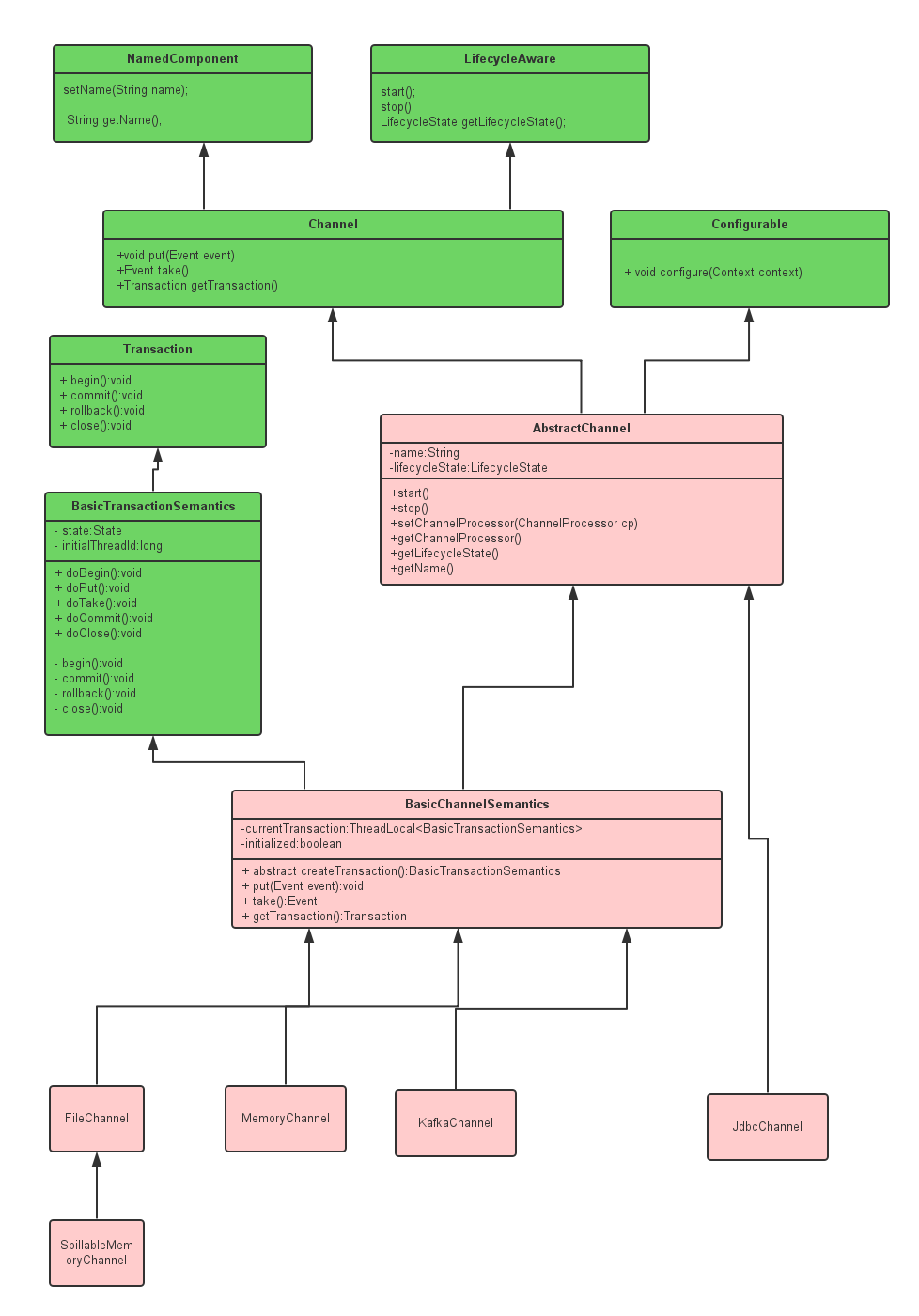Flume 源码学习(二)Channel组件介绍
Channel是Flume中第二个组件,是日志从source传输到sink的通道。根据Flume文档,channel有两个重要衡量指标:
- Reliability:可依赖性。即channel需要接收到的event被下个agent接收或被最终的sink接收。Flume使用事务来保证Reliability。支持可以持久化的基于文件系统的FileChannel和不能保证持久化的MemoryChannel
- Recoverability:可恢复性。如果发生Failure,是否能够恢复数据;Flume支持可恢复的FileChannel和不支持恢复但传输速度快得MemoryChannel
类图
首先还是来看Channel相关类的类图:

两个望文生义的类的说明:
| 接口名 | 作用 |
|---|---|
| BasicChannelSemantics | 基本的channel语义的实现,包含了Threadlocal保存的Transaction实例。通俗的讲就是采用ThreadLocal来保存和当前Channel关联的Transaction的抽象父类 |
| SpillableMemoryChannel | 集成了FileChannel和MemoryChannel功能,首先用MemoryChannel,在这个channel达到capacity再改用FileChannel继续 |
MemoryChannel
我们首先来看MemoryChannel的实现,MemoryChannel有几个重要参数可以配置:
- capacity:Channel的最大容积
- transactionCapacity:一个事务最多可以包含多少个events
- byteCapacity:Channel的Queue的最大的byte 容积
- byteCapacityBufferPercent:定义了byteCapacity和评估的event size之间缓冲的百分比,概要的说就是如果MemoryChannel中等待写出的EventList的byte size最多只能达到(1-byteCapacityBufferPercent/100)*100%,剩下的是缓冲buffer(如果没有buffer,很可能出现内存溢出)
- keep-alive:定义了允许在队列中等待的最大秒数
根据上面的类图,我们知道MemoryChannel继承了BasicChannelSemantics抽象类,而后者
有一个抽象方法createTransaction()需要子类自己实现。所以,MemoryChannel中第一个重要的功能就是基于内存的Transaction的实现。MemoryChannel中是MemoryTransaction这一个内部类,代码如下:
private class MemoryTransaction extends BasicTransactionSemantics {
private LinkedBlockingDeque<Event> takeList;//从channel中take,准备推送到sink
private LinkedBlockingDeque<Event> putList;//从source put到channel的队列
private final ChannelCounter channelCounter;//counter
private int putByteCounter = 0;//put的字节counter
private int takeByteCounter = 0;//take的字节counter
public MemoryTransaction(int transCapacity, ChannelCounter counter) {
putList = new LinkedBlockingDeque<Event>(transCapacity);
takeList = new LinkedBlockingDeque<Event>(transCapacity);
channelCounter = counter;
}
//往putList增加Event,如果没有空间抛错
@Override
protected void doPut(Event event) throws InterruptedException {
channelCounter.incrementEventPutAttemptCount();
int eventByteSize = (int)Math.ceil(estimateEventSize(event)/byteCapacitySlotSize);
if (!putList.offer(event)) {
throw new ChannelException(
"Put queue for MemoryTransaction of capacity " +
putList.size() + " full, consider committing more frequently, " +
"increasing capacity or increasing thread count");
}
putByteCounter += eventByteSize;
}
//从外部类MemoryChannel的等待Take的Event List中take一个过来放到事务的takeList里面,作为本次事务需要提交的Event
@Override
protected Event doTake() throws InterruptedException {
channelCounter.incrementEventTakeAttemptCount();
if(takeList.remainingCapacity() == 0) {//首先判断takeList是否还有空间
throw new ChannelException("Take list for MemoryTransaction, capacity " +
takeList.size() + " full, consider committing more frequently, " +
"increasing capacity, or increasing thread count");
}
if(!queueStored.tryAcquire(keepAlive, TimeUnit.SECONDS)) {//通过queueStored这Semaphore信号来判断外部类MemoryChannel是否有queued Event等待被take,用信号量而不是直接判断queueStored(LinkedBlockingDeque<Event>)的poll()主要是后者会阻塞queueStored上的所有操作,尤其是包括为空得情况下put操作。可以提高throughput。
return null;//没有获取到,意味着可能queue当前为空。
}
Event event;
synchronized(queueLock) {
event = queue.poll();//queueStored不为空。
}
Preconditions.checkNotNull(event, "Queue.poll returned NULL despite semaphore " +
"signalling existence of entry");
takeList.put(event);
//计算taken的byte
int eventByteSize = (int)Math.ceil(estimateEventSize(event)/byteCapacitySlotSize);
takeByteCounter += eventByteSize;
return event;
}
//实际事务的提交
@Override
protected void doCommit() throws InterruptedException {
int remainingChange = takeList.size() - putList.size();
if(remainingChange < 0) {//take size < putsize,sink的消费速度慢于source的产生速度
if(!bytesRemaining.tryAcquire(putByteCounter, keepAlive,
TimeUnit.SECONDS)) {//判断是否有足够空间接收putList中events所占的空间
throw new ChannelException("Cannot commit transaction. Byte capacity " +
"allocated to store event body " + byteCapacity * byteCapacitySlotSize +
"reached. Please increase heap space/byte capacity allocated to " +
"the channel as the sinks may not be keeping up with the sources");
}
if(!queueRemaining.tryAcquire(-remainingChange, keepAlive, TimeUnit.SECONDS)) {//判断queue是否还有空间接收(因为生产速度快于消费速度)
bytesRemaining.release(putByteCounter);
throw new ChannelFullException("Space for commit to queue couldn't be acquired." +
" Sinks are likely not keeping up with sources, or the buffer size is too tight");
}
}
int puts = putList.size();//事务期间生产的event
int takes = takeList.size();//事务期间等待消费的event
synchronized(queueLock) {
if(puts > 0 ) {
while(!putList.isEmpty()) {
if(!queue.offer(putList.removeFirst())) {//将putList中新生产的Events保存到queue
throw new RuntimeException("Queue add failed, this shouldn't be able to happen");
}
}
}
putList.clear();//重置事务的putList,下同
takeList.clear();
}
bytesRemaining.release(takeByteCounter);
takeByteCounter = 0;
putByteCounter = 0;
queueStored.release(puts);//从queueStored释放puts个信号量
if(remainingChange > 0) {
queueRemaining.release(remainingChange);//queueRemaining释放remainingChange个信号量
}
if (puts > 0) {
channelCounter.addToEventPutSuccessCount(puts);
}
if (takes > 0) {
channelCounter.addToEventTakeSuccessCount(takes);
}
channelCounter.setChannelSize(queue.size());
}
@Override
protected void doRollback() {
int takes = takeList.size();
synchronized(queueLock) {
Preconditions.checkState(queue.remainingCapacity() >= takeList.size(), "Not enough space in memory channel " +
"queue to rollback takes. This should never happen, please report");
while(!takeList.isEmpty()) {
queue.addFirst(takeList.removeLast());//把takelist中的events原封不动的放回queue
}
putList.clear();
}
bytesRemaining.release(putByteCounter);
putByteCounter = 0;
takeByteCounter = 0;
queueStored.release(takes);
channelCounter.setChannelSize(queue.size());
}
}通过上面的代码我们可以看到MemoryChanne的createTransaction内部使用的是基于内存的MemoryTransaction,没有实现持久化。在生产和消费的过程中,非常关注byteCapacity,防止内存溢出。
FileChannel
接下来来看FileChannel的实现TBD
























 521
521











 被折叠的 条评论
为什么被折叠?
被折叠的 条评论
为什么被折叠?








